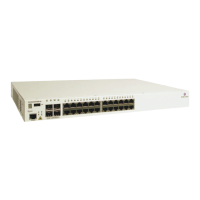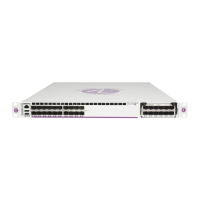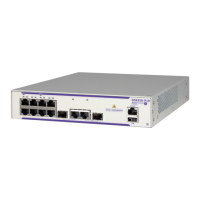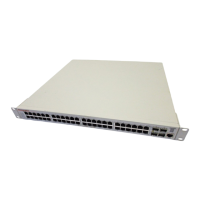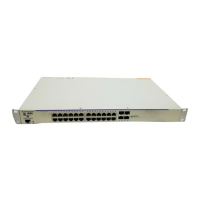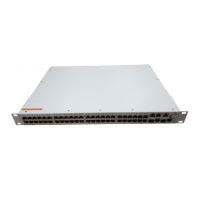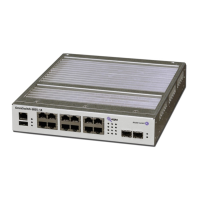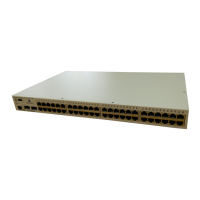Do you have a question about the Alcatel-Lucent OmniSwitch 6465 and is the answer not in the manual?
Details on the OS6465-P6 model, including front/rear panel and specifications.
Details on the OS6465-P12 model, including front/rear panel and specifications.
Details on the OS6465-P28 model, including front/rear panel and specifications.
Details on the OS6465T-12 model, including front/rear panel and specifications.
Details on the OS6465T-P12 model, including front/rear panel and specifications.
Procedures for installing the OmniSwitch hardware, including required tools and site prep.
Guidelines to protect equipment against electrical surges and proper cabling.
Instructions for unpacking and installing the switch chassis.
List of items typically included with the OmniSwitch.
Information regarding the weight of different OmniSwitch models.
Steps for connecting network and management cables to the switch.
How to establish a serial connection to the switch console port.
Procedure for powering on and booting the OmniSwitch.
Explanation of LEDs indicating switch status during boot.
Steps to complete during the initial login and setup process.
How to log in to the switch using default credentials.
Procedures to enable remote access session types like Telnet and Web.
Steps to change the administrator login password for security.
How to configure the switch's time zone and Daylight Savings Time.
Commands to set the current date and time on the switch.
Configuring administrative contact, system name, and location.
Command to display current configuration changes.
Command to save the configured settings to persistent memory.
Detailed information on various OmniSwitch chassis models, including front/rear panels.
Guidelines and steps for mounting the switch in racks or via DIN rail.
Overview of supported power supply models and their compatibility.
Instructions for connecting AC input and DC output power cords.
Procedures for properly grounding the switch chassis for safety.
Information on alarm relay feature, events, and configuration.
How to monitor chassis temperature and slot information.
Overview of the chapter's content on Power over Ethernet features.
General specifications for the OmniSwitch's PoE support.
Wattage availability based on power supplies and ambient temperature.
How devices are classified and power is adjusted based on class.
Enabling, disabling, and managing PoE service on ports and slots.
Setting specific power limits for individual switch ports.
Setting overall power limits for a switch slot.
Assigning priority levels (low, high, critical) to ports for power management.
Enabling capacitor detection for legacy IP phones.
Managing power in low-budget scenarios by adjusting port power.
Rules for power allocation when the budget is tight, based on port priority.
Using CLI commands to monitor current PoE status and statistics.
Statement of compliance with EU directives for CE marking.
Information regarding the disposal of the product at its end of life.
Table detailing hazardous substance content in product parts for China.
Table detailing hazardous substance content in product parts for Taiwan.
Warning about chemical exposure according to California law.
Summary of all safety and EMC standards the product complies with.
List of specific safety standards met by the product.
Details on electromagnetic compatibility and immunity standards.
Standards related to environmental testing of the product.
Compliance requirements for industrial environments.
FCC compliance for Class A digital devices operated in commercial environments.
Canadian statement regarding radio noise emissions limits.
Japan Approvals Institute of Telecommunications Equipment compliance.
Warning for Class A products used in domestic settings.
Statement regarding Korean electromagnetic conformity regulations.
Japanese statement on voluntary control for interference.
Warnings for Class A products in residential use in Taiwan/China.
Safety warning regarding Class 1M laser radiation.
Caution against installing exposed network cables outdoors.
Importance of keeping blank panels installed for airflow and protection.
Warning against performing operations during electrical storms.
Requirement for qualified personnel to perform installation.
Warning about invisible laser radiation from open ports.
Precaution to keep hands away from power supply bays and backplane.
Necessity to disconnect all power before servicing or moving the unit.
Guidelines for connecting power cords to properly wired and earthed receptacles.
Requirement for connecting ground wires of DC power supplies to common earth ground.
Reminder to read the Getting Started Guide for safety information.
Requirement to install equipment in a secure location with limited access.
Procedures for using an anti-static wrist strap to prevent ESD damage.
| Model | OmniSwitch 6465 |
|---|---|
| Product Type | Switch |
| Switching Capacity | 128 Gbps |
| Jumbo Frame Support | Yes |
| Power over Ethernet (PoE) | Yes |
| Uplink Ports | 4 x 10G SFP+ |
| MAC Address Table Size | 16K |
| Management | CLI, Web, SNMP |
| Features | VLAN, QoS, Link Aggregation |
| Operating Temperature | 0°C to 45°C |
| Operating Humidity | 10% to 90% (non-condensing) |


